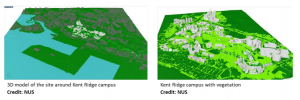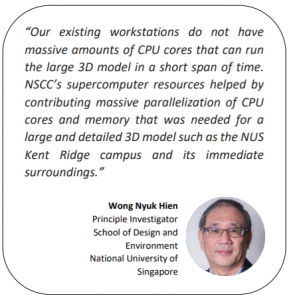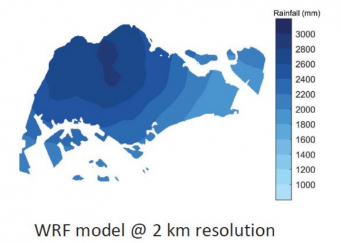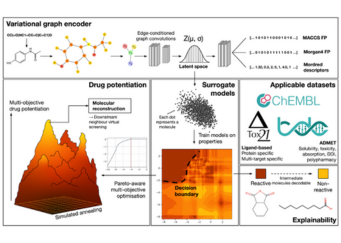A research team from NUS is tapping on NSCC’s supercomputing resources to develop an urban microclimate model for the local Singapore environment at the NUS Kent Ridge campus test-bed environment.

As a densely-populated city-state, Singapore’s rapid urban development and growing population poses challenges, especially in trying to provide its residents a healthy, comfortable and liveable environment.
Rising temperature is one of the main environmental concerns. The annual average surface temperature in Singapore has increased from 26.6°C in 1972 to 27.7°C in 2014 (Meteorological Service Singapore (MSS), 2015) and is predicted to rise by 1.4-4.6°C by 2099 in the context of global warming (MSS, 2015). The urban heat island (UHI) effect signifies that a city area is significantly warmer than its surrounding rural areas, which is indeed found to be quite evident. The densely built urban areas, such as central business district (CBD) area, is up to 4°C hotter than green spaces (e.g., parks, forests, catchment areas, etc.) during hot afternoons.
A group of researchers at National University of Singapore’s School of Design and Environment are making use of the NUS Kent Ridge campus as a test-bed environment for model calibration and validation to develop an urban microclimate model for the local Singapore environment.

The biggest challenge the team faced was the lack of an integrated, clean and detailed 3D model that is suitable for the requirements of the environmental simulation. The integration of the buildings, structures, tree canopies and terrain require significant computational time to ensure they fit together nicely. In addition, the most common material properties on the surfaces needed to be identified and measured on site. Other issues included getting appropriate boundary conditions from weather stations or Weather Research and Forecasting (WRF) Models for the simulation, and the lack of parallel CPU cores to handle the simulation of very large 3D models.
Through the use of NSCC’s high performance computing resources, the team was able to carry out their research with the aim to develop a multiscale microclimate model for simulating the UHI effect (mesoscale phenomenon) and local hotspots (microscale) on the neighbourhood scale. The team is also integrating the urban microclimate model to the 3D model of the NUS campus, i.e., Virtual NUS, for enhancing the simulation and visualisation and using the NUS Kent Ridge Campus to validate the developed model.
The results of the project would ultimately serve to predict the impact of the current urban microclimate as well as future scenarios where physical and boundary condition alterations are made to the current condition.
To find out more about the NSCC’s HPC resources and how you can tap on them, please contact [email protected].
NSCC NewsBytes August 2021
Other Case Studies
Enhancing Weather Prediction in Singapore: Leveraging Climate Model Simulations for Precision
Researchers from NUS Tropical Marine Science Institute are leveraging supercomputing to fine-tune Weather Research and Forecasting (WRF) Model and downscale hundreds of years of...
Keeping drones safe in urban airspaces
Researchers from NTU tap on high performance computing to identify hazardous airspaces through urban weather simulations in order to facilitate effective route planning and...
Advancing Drug Discovery Research using NSCC HPC resources
Researchers from Nanyang Technological University (NTU) are applying variational graph encoders as an effective generalist algorithm in computer-aided drug design (CADD)....


